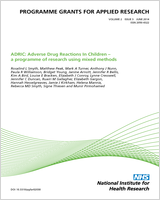Included under terms of UK Non-commercial Government License.
NCBI Bookshelf. A service of the National Library of Medicine, National Institutes of Health.
Gunnell D, Hawton K, Bennewith O, et al. A multicentre programme of clinical and public health research in support of the National Suicide Prevention Strategy for England. Southampton (UK): NIHR Journals Library; 2013 Oct. (Programme Grants for Applied Research, No. 1.1.)

A multicentre programme of clinical and public health research in support of the National Suicide Prevention Strategy for England.
Show detailsWe define suicide as ‘any act of self-damage which on the balance of evidence was considered to be deliberately initiated and which resulted in the individual's death’.
All vignettes will be independently coded by DG, KH and NK blind to the year of death. Based on the available information each investigator will rate the probability that a particular death was suicide as:
- 1 = high
- 2 = moderate
- 3 = low
- 9 = not clear.
For deaths coded as ‘low’ or ‘not clear’ likelihood of suicide, the most likely alternative cause of death will be coded as one of the following:
- accident
- homicide
- misadventure (the unintended outcome of an intended action)
- other – please specify.
The following indicators will contribute to decision-making (based in part on those used by Cooper and Milroy26):
- a suicide note (likely high probability)
- prima facie evidence of intent (e.g. statement to others that person intended to take his or her life) (high probability)
- the method used – hanging/firearm/carbon monoxide poisoning from car/barbecue charcoal (high probability of deliberate act) [although exceptions are possible, for example autoerotic hanging (as indicated by presence of pornography/cross-dressing)]
- previous acts of non-fatal self-harm (increased probability)
- a history of previous psychiatric illness with associated suicide risk, for example schizophrenia/major depression was seen as increasing the possibility that an act was suicide
- circumstantial evidence as to the most reasonable and probable explanation for the death
- if there are clear psychosocial stressors around the time of the act that might plausibly have prompted some to kill themselves (e.g. bankruptcy/impending criminal conviction/marriage breakdown), these were taken to increase the likelihood of suicide
- if there is evidence of a high level of alcohol or illicit drug ingestion prior to the act, this may introduce some degree of uncertainty (unless other indicators such as a note are present – moderate)
- if there is insufficient information (e.g. someone has been dead for several weeks and post-mortem blood levels are unreliable), code as not clear
- if other people involved with the case (medical staff/family) felt that suicide was likely
- if the blood level of a drug is considerably above the therapeutic dose this is a pointer to deliberate overdose rather than accidental overdosing, for example to relieve pain in someone who has high blood alcohol levels.
- Protocol for coding vignettes - A multicentre programme of clinical and public h...Protocol for coding vignettes - A multicentre programme of clinical and public health research in support of the National Suicide Prevention Strategy for England
Your browsing activity is empty.
Activity recording is turned off.
See more...